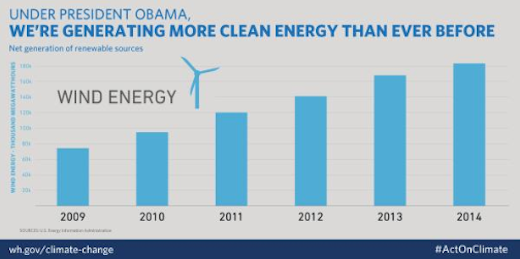
President Obama is committed to improving the nation’s electric grid and spurring the development of renewable energy. Since the President took office, the United States has increased electricity generation from solar energy 20 fold and tripled the amount of electricity we generate from wind. To further build on this progress, the Obama Administration remains committed to modernizing and improving our transmission grid. Improving our transmission grid will make electricity more reliable, save consumers money, catalyze the transition to a clean energy economy, and reduce the carbon pollution that is leading to climate change.

That is why, today, the Administration is announcing new investments in the next generation of power transmission and smart grid technology in 13 states and executive actions that will make it easier and faster to permit transmission lines, including:
-
New Funding for Transmission Lines in Rural America. Agriculture Secretary Tom Vilsack today announced nearly $350 million in funding for 15 rural electric infrastructure projects to build or improve more than 1,800 miles of transmission and distribution lines for rural electric cooperatives and utilities in 13 states. Upgrading the electric grid will not only improve reliability and better manage costs, but it will also bring jobs and increased economic opportunities, helping to build a sustainable and dynamic future for rural residents and businesses.
-
Improving Coordination: This year, the Department of Energy will propose a revised pre-application process for permitting significant onshore electric transmission projects. The design of the proposed process is based on lessons learned from the Rapid Response Transmission Team (RRTT) projects, interagency experience, public input that encourages early engagement with stakeholders, and early identification of potential challenges so that project applications submitted are accurate and complete leading to a simplified review process for permitting transmission lines.
-
Increased BLM Funding for Southwest Transmission Corridors. The Bureau of Land Management will provide an additional $500,000 in 2015 to augment existing funding targeted toward assessing high priority transmission corridors in the Southwest (Nevada, Arizona, California) – an area with great potential for additional renewable energy development – and identifying energy corridors where conflicts with other resources would be minimized. The 2016 President's Budget also includes a request for an additional $5 million for work on transmission corridors.
- New Cost Recovery Authority and Implementation Guidance: The Army Corps of Engineers will issue new guidance in the coming weeks for accepting funds from public-utility and natural gas companies seeking to expedite permit review for transmission and other public purposes projects. This includes generation, transmission or distribution of electricity, and projects involving the transportation and/or distribution of natural gas.
"This announcement is absolutely the right approach to modernizing our nation’s dated energy infrastructure. Taking a closer look at key transmission corridors, loan guarantees for cooperative utilities and streamlining the federal review process will all drive greater market certainty for clean energy. For the 42 million Americans served by rural electric cooperatives, there is no question that the local economic development benefits of large clean energy projects hinges on the availability of transmission capacity to bring new energy to growing markets.
In the West, where 52% of the acreage is owned by the Federal Government, the time, effort and capital required to permit transmission lines through federal lands has been raised often as a bottleneck to clean energy deployment. These funding announcements and improved coordination are a thoughtful response to such concerns. "
—Bill Ritter, Jr., Director, Center for the New Energy Economy and 41st Governor of Colorado

Today’s actions build on the tremendous progress the Administration has already made improving the nation’s electric transmission infrastructure. Since the President took office:
-
The Department of the Interior’s Bureau of Land Management (BLM) approved 46 major electric transmission line projects, of which 29 are currently in service. Cumulatively, the 46 projects total over 2,300 miles, 1,300 miles of which cross BLM-managed lands. From 2012 to 2013 alone, the BLM approved permits which will enable construction of nearly 1,000 miles of transmission lines across Federal lands;
-
The Department of Agriculture’s Rural Utilities Service financed nearly 7,400 total miles of transmission and distribution lines;
-
The U.S. Department of Energy (DOE) issued 3 Presidential permits for the construction, operation, connection and maintenance of electric transmission lines crossing the U.S. international border, spanning approximately 551 miles. Through the Western Power Marketing Administration’s (WAPA) Transmission Investment Program (TIP), the DOE invested $251 million in two transmission projects, totaling 323 miles; and
- After over a decade of lower build-out, the amount of new circuit miles to the Nation’s transmission system increased in recent years.
More information about the actions we have taken to catalyze the development of transmission infrastructure to better integrate renewable sources of electricity into the grid is available in a new report Modernizing our Electric Transmission Infrastructure and Driving the Development of Clean Energy.


